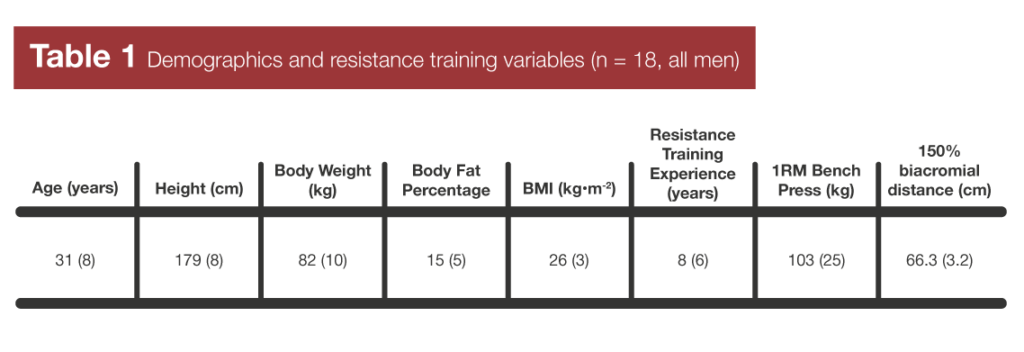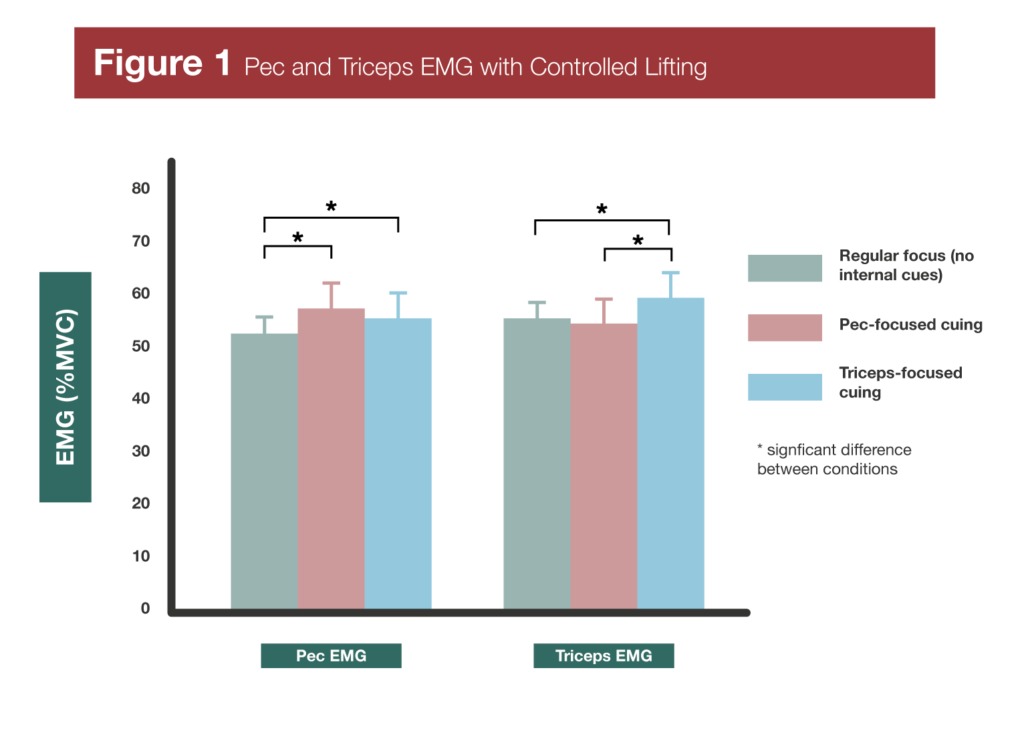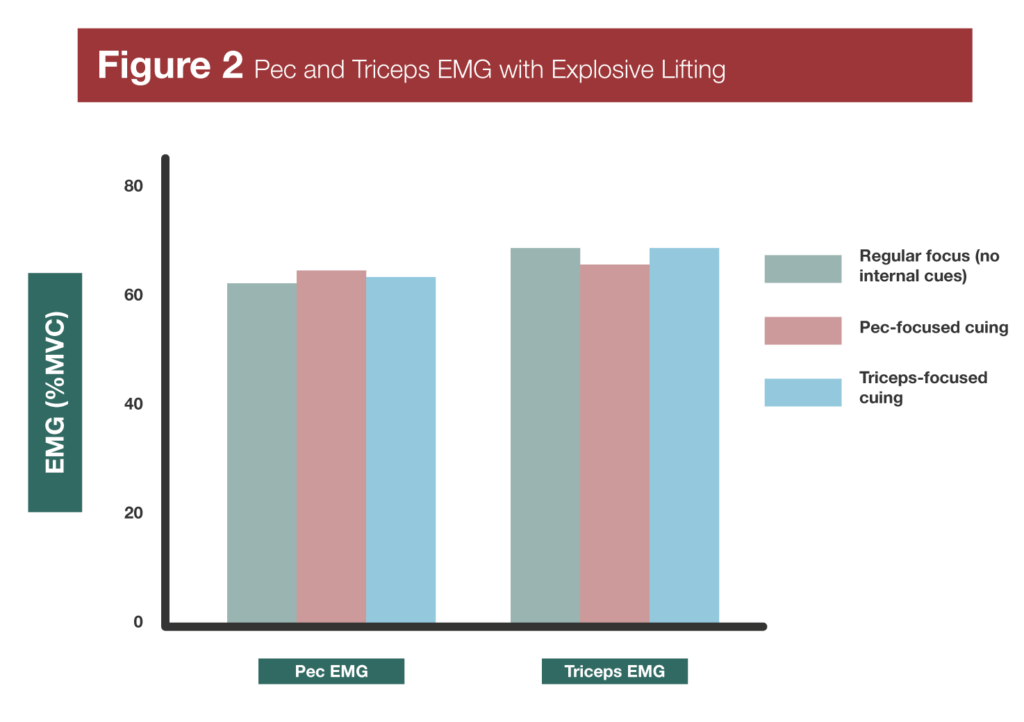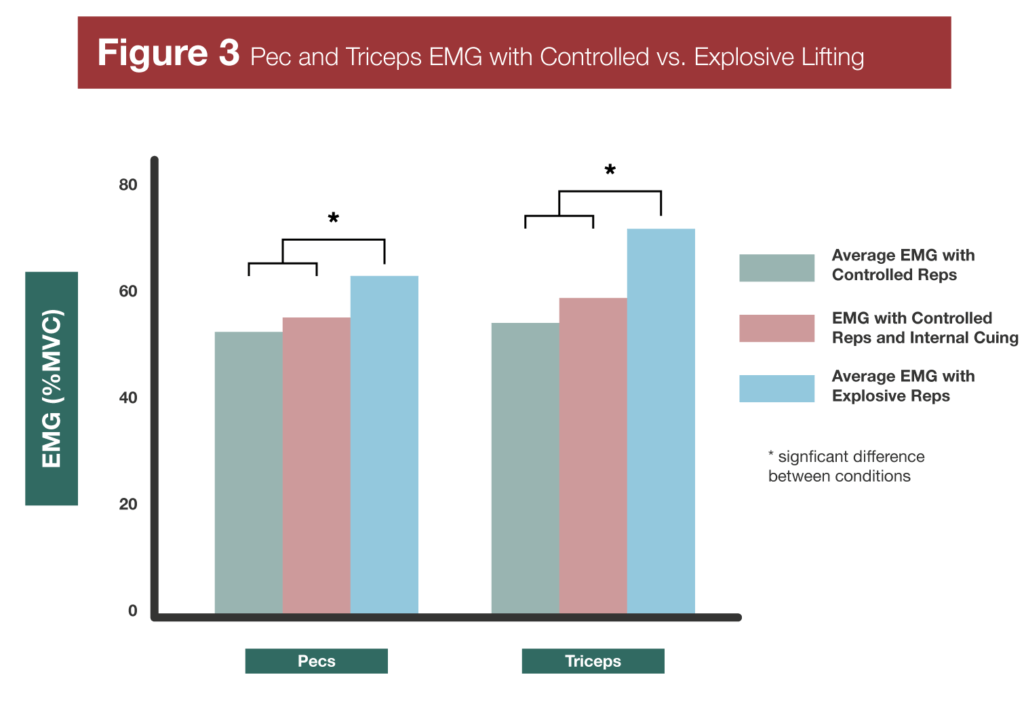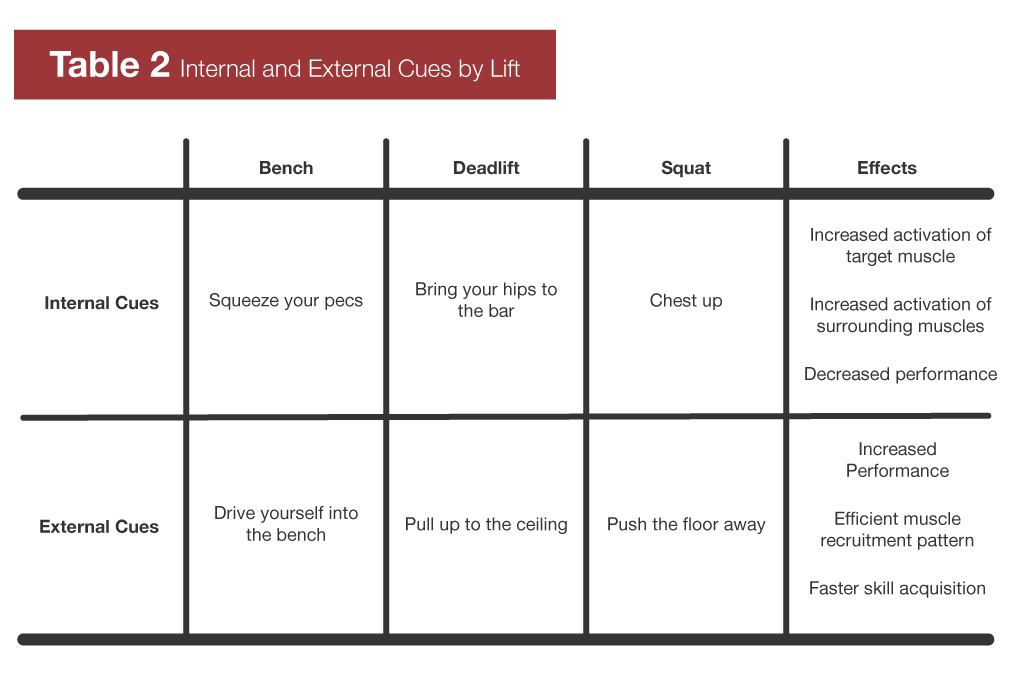Note: This article is from a previous issue of MASS, my monthly research review with Eric Helms and Mike Zourdos. Each issue of MASS contains at least 9 pieces of content. At least 6 (generally 7) are articles that each break down the findings and application of a recent study, 2 are videos covering broader topics, and we occasionally have guest posts or special features for the last article.
This article is a review of a 2017 study from Calatayud et al titled Influence of Different Attentional Focus on EMG Amplitude and Contraction Duration During the Bench Press at Different Speeds.
Key Points
- With low (50% 1RM) loads on the bench press, trained participants were able to slightly increase pec and triceps activation by focusing on the target muscle, but only when performing slow reps.
- When trying to lift explosively, actively focusing on using the pecs or triceps didn’t affect muscle activation.
- Trying to press the weight explosively resulted in more muscle activation than pressing the weight slowly, regardless of cues.
Bodybuilders and physique athletes swear they can feel a stronger contraction during an exercise in the target muscle when they actively focus on using that muscle: the “mind-muscle connection.” In fact, there’s considerable research to support that premise; internal cues (focusing on part of the body) consistently lead to increased muscle activation compared to no cues or external cues (focusing on the desired outcome of the movement).
However, increased muscle activation due to internal cues may be an inconsistent phenomenon. When you try to move a weight as fast as possible, your nervous system will already be trying to recruit a lot of motor units in order to maximize force and power output; if you use internal cues while already trying to push a weight as fast as possible, will muscle activation still increase? This study set out to investigate this question. Participants performed bench presses with 50% of one-repetition maximum (1RM) at a controlled cadence and at maximal speed, using either no cues or cues to focus on using their pecs or triceps. At slow speeds, internal cues led to increased pec and triceps activation. However, muscle activation was higher at high speeds than low speeds (including low speeds with internal cues), and internal cues failed to further increase muscle activation. Therefore, simply trying to move each rep as fast as possible likely maximizes muscle activation, and using additional internal cues may only increase muscle activation when intentionally moving reps slowly.
Purpose and Research Questions
With dynamic lifts, we have evidence that internal cues can increase activation of the targeted muscle and surrounding musculature (2, 3, 4, 5). However, it’s unclear whether internal cues will still increase muscle activation in a targeted muscle when the focus is on lifting explosively. Therefore, this study sought to verify the prior finding that focusing on the “mind-muscle connection” could increase activation of the targeted muscles when lifting at slow tempos, and to then examine whether internal cues could still increase activation of the target muscle when lifting explosively. A secondary purpose of this study was to examine the effects of internal cues on contraction duration of the prime movers in the bench press at both controlled and explosive tempos. The authors hypothesized that internal cues would not increase muscle activation or affect contraction duration with explosive lifting.
Subjects and Methods
Subjects
Eighteen male volunteers took part in the study. They all had at least one year of training experience, with a mean of eight years, and an average bench press of 103±25kg (227±55lbs), which is pretty solid for this type of research. More information about the participants can be seen in Table 1.
Experimental Protocol
This study took place over two visits to the lab. The first visit was a familiarization session where the participants were acquainted with the protocol and tested their 1RMs. The experimental session took place at least two days later.
During the experimental session, the participants performed 6 sets of 3 reps with 50% of their 1RM on the bench press. For three of the sets, the participants were instructed to move the weight at a controlled speed, with two-second eccentrics and two-second concentrics. For the other three sets, they were instructed to lower the bar with a controlled cadence (two second eccentric), but to press the bar as fast as they could (explosive concentric). At each speed, the participants performed one set without any internal cues (they were instructed, “during this set, lift the barbell in a regular way”), one set with internal cues focusing on the pecs (“during this set, try to focus on using your chest muscles only”), and one set with internal cues focusing on the triceps (“during this set, try to focus on using your triceps muscles only”). The speeds and cues were assigned in a randomized order for each participant.
Measurements
Electromyography (EMG) was used to assess muscle activation. Electrodes were placed in four locations on the pecs and three locations on the triceps to assess electrical activity in the entire muscle. The peak EMG readings during the experimental session were normalized by dividing the experimental EMG values by EMG values obtained during maximal voluntary contractions. The duration of muscle contraction was also measured during the explosive conditions, defined as the duration between the start of the concentric, and the point when EMG values decreased to below 5% of the muscle activity range ((maxEMG-minEMG)*0.05).
Findings
Electromyography (EMG)
During the sets performed with controlled concentrics, the internal cues that focused on either the pecs or triceps significantly (p<0.05) increased pec EMG (+6% for pec cues, and +4% for triceps cues) relative to the trial without internal cues. Furthermore, triceps internal cues increased triceps EMG (+4%) during the sets with controlled concentrics. However, internal cues targeting the pecs and triceps failed to increase pec or triceps activation during the explosive trials. Furthermore (and most importantly), EMG was significantly higher for both the pecs and triceps during the explosive trials than the regular trials regardless of cuing.
Contraction Duration
There were no significant differences between conditions for contraction durations during the explosive trials.
Interpretation
As you’ll remember from a previous MASS article, internal cues focus on a particular part of the body (how it moves or how it feels), while external cues focus on the outcome of the movement. Some examples of internal and external cues can be seen below:
In general, internal cues lead to increased muscle activation, while external cues lead to enhanced performance. In this study, internal cues (focusing on the pecs or triceps) did lead to increased muscle activation when lifting with a controlled tempo.
The common takeaway from this study for many people may be that focusing on the “mind-muscle connection” can increase pec and triceps activation with a controlled tempo. However, the most important findings, in my opinion, were:
- When trying to lift explosively, internal cues don’t seem to increase muscle activation.
- When trying to lift explosively, even without internal cues, muscle activation is higher than when lifting with a slower tempo, even with internal cues.
This broadly mirrors the findings of a prior bench press study (6) that found substantial increases in pec and triceps activation with 50% of 1RM loads when using internal cues, but much smaller increases for the pecs and no difference for the triceps with heavier (80% of 1RM loads), further indicating that when effort increases, the ability for internal cues to increase muscle activation diminishes.
This study reinforces the idea that you should generally try to maximize concentric velocity with each rep. A prior study (7) found that attempting to move each rep as fast as possible led to roughly twice the strength gains as moving each rep at half of maximum velocity, even with volume and intensity controlled.
From a mechanistic perspective, it makes sense that trying to move every rep explosively would be the optimal strategy for strength gains. Force = Mass ×Acceleration, so, with a given mass, you can increase force output by increasing acceleration. Since trying to move each rep as fast as possible increases force output, that will a) require more motor units to be recruited and b) increase the specificity of the training stimulus for strength gains.
This isn’t to say that slower tempos and internal cues can’t have their place. When learning a new exercise, for example, slowing things down can help you learn technique and better feel your positioning in the movement. Anecdotally, internal cues also seem to work well for better integrating a particular muscle into a motor pattern (for example, many people initially have issues feeling their lats in pulling movements; internal cues can help them integrate their lats into the movement, anecdotally). Finally, if you’re training around an injury and therefore using lower loads with slower tempos, internal cues seem to be effective at increasing activation of the target muscle in that scenario, likely helping you increase the training stimulus without further joint discomfort. However, under most circumstances, lifting explosively seems to be the way to go.
One final note: If you’ve been subscribed to MASS for a few months, you may have noticed that the findings of this study differed from those of a prior study we reviewed(5). I think the most likely reason for this discrepancy has to do with the mode of exercise; they used isokinetic knee extensions in that study, while this study used bench press. As such, this study is probably more applicable to us.
Next Steps
As always, it would be cool to see this study replicated with high-level bodybuilders who (presumably) have more well-developed “mind-muscle connections” to see how well it generalized. Furthermore, long-term studies comparing internal versus external cues for strength gains are lacking.
Application and Takeaways
Under most circumstances, you should probably try to apply maximum velocity to the concentric portion of each rep. When you do so, you probably don’t need to worry about internal cues (the “mind-muscle connection”).
Get 9 articles like this every month
If you enjoyed this article, consider subscribing to the MASS research review. We publish 9 research review articles – just like this one – every month. You can get an 80-page free issue (Value: $29) or go ahead and subscribe.
Share this on Facebook & join in the conversation
References
- Calatayud J, Vinstrup J, Jakobsen MD, Sundstrup E, Colado JC, Andersen LL. Influence of different attentional focus on EMG amplitude and contraction duration during the bench press at different speeds. J Sports Sci. 2017 Aug 10:1-5. doi: 10.1080/02640414.2017.1363403.
- Marchant DC, Greig M, Scott C. Attentional focusing instructions influence force production and muscular activity during isokinetic elbow flexions. J Strength Cond Res. 2009 Nov;23(8):2358-66. doi: 10.1519/JSC.0b013e3181b8d1e5.
- Lohse KR, Sherwood DE, Healy AF. Neuromuscular effects of shifting the focus of attention in a simple force production task. J Mot Behav. 2011;43(2):173-84. doi: 10.1080/00222895.2011.555436.
- Wulf G, Dufek JS, Lozano L, Pettigrew C. Increased jump height and reduced EMG activity with an external focus. Hum Mov Sci. 2010 Jun;29(3):440-8. doi: 10.1016/j.humov.2009.11.008.
- Marchant DC, Greig M. Attentional focusing instructions influence quadriceps activity characteristics but not force production during isokinetic knee extensions. Hum Mov Sci. 2017 Apr;52:67-73. doi: 10.1016/j.humov.2017.01.007. Epub 2017 Jan 28.
- Snyder BJ, Fry WR. Effect of verbal instruction on muscle activity during the bench press exercise. J Strength Cond Res. 2012 Sep;26(9):2394-400. doi: 10.1519/JSC.0b013e31823f8d11.
- González-Badillo JJ, Rodríguez-Rosell D, Sánchez-Medina L, Gorostiaga EM, Pareja-Blanco F. Maximal intended velocity training induces greater gains in bench press performance than deliberately slower half-velocity training. Eur J Sport Sci. 2014;14(8):772-81. doi: 10.1080/17461391.2014.905987.


